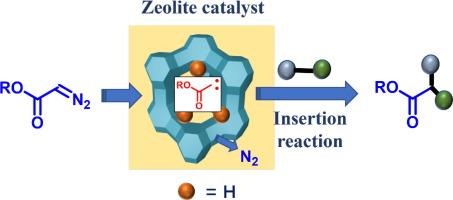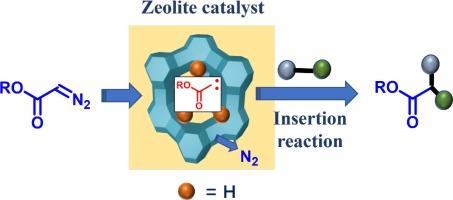Dealuminated H–Y zeolites generate, stabilize and catalytically insert carbenes from diazocarbonyl compounds
IF 6.5
1区 化学
Q2 CHEMISTRY, PHYSICAL
引用次数: 0
Abstract
Carbenes are among the most powerful reactants in organic synthesis, with capacity to insert into a variety of otherwise stable bonds, and generate two new bonds in a straightforward manner. However, the intrinsic instability of such carbenes makes them to be catalytically generated, in–situ, from precursors such as diazocarbonyl compounds, and the catalyst, in turn, also controls the subsequent insertion reaction. The catalyst is generally a metal complex in solution, mainly Cu, Ag or Rh, but also others, including protons in rare cases. Here we show that carbenes are generated, stabilized and inserted into C–C, C–H, O–H, N–H, Si–H and O–O bonds after reacting diazocarbonyl compounds with catalytic amounts of metal–free, commercially available dealuminated H–Y zeolites. These results open the way to design carbene–mediated organic reactions on readily available and reusable catalytic solids without involving metals.


脱铝 H-Y 沸石从重氮羰基化合物中生成、稳定和催化插入烯碳化合物
烯碳化合物是有机合成中最强大的反应物之一,能够插入各种原本稳定的键中,并以直接的方式生成两个新键。然而,由于这些碳烯的内在不稳定性,它们需要在原位由重氮羰基化合物等前体催化生成,而催化剂反过来也控制着随后的插入反应。催化剂通常是溶液中的金属复合物,主要是铜、银或铑,也有其他金属,包括极少数情况下的质子。在这里,我们展示了在重氮羰基化合物与催化量的无金属、市售脱铝 H-Y 沸石反应后,碳烯的生成、稳定和插入 C-C、C-H、O-H、N-H、Si-H 和 O-O 键。这些结果为在不涉及金属的情况下,在随时可用且可重复使用的催化固体上设计碳介导的有机反应开辟了道路。
本文章由计算机程序翻译,如有差异,请以英文原文为准。
求助全文
约1分钟内获得全文
求助全文
来源期刊

Journal of Catalysis
工程技术-工程:化工
CiteScore
12.30
自引率
5.50%
发文量
447
审稿时长
31 days
期刊介绍:
The Journal of Catalysis publishes scholarly articles on both heterogeneous and homogeneous catalysis, covering a wide range of chemical transformations. These include various types of catalysis, such as those mediated by photons, plasmons, and electrons. The focus of the studies is to understand the relationship between catalytic function and the underlying chemical properties of surfaces and metal complexes.
The articles in the journal offer innovative concepts and explore the synthesis and kinetics of inorganic solids and homogeneous complexes. Furthermore, they discuss spectroscopic techniques for characterizing catalysts, investigate the interaction of probes and reacting species with catalysts, and employ theoretical methods.
The research presented in the journal should have direct relevance to the field of catalytic processes, addressing either fundamental aspects or applications of catalysis.
 求助内容:
求助内容: 应助结果提醒方式:
应助结果提醒方式:


